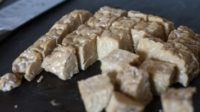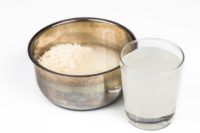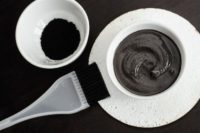Some homemade remedies made with easy to find natural plants are excellent economical choices to treat arthritis. They’re usually able to decrease inflammation in the joint and helping relieve pain. Therefore, these homemade remedies should never be used as a substitute for the treatment prescribed by a doctor. They only help to alleviate the pain or prevent it from recurring. 1. Homemade rosemary remedy Ingredients: – 1 teaspoon of fresh or dried rosemary leaves; – 250 ml of boiling water; Instructions: Add the rosemary leaves to a cup of boiling water and let it steep for 10 minutes. Then strain [More]
Gluten is part of our daily lives, due to the large number of foods that contain gluten that we eat every day. We do this without realizing how much gluten we are ingesting. Breads, cakes, pizza, pastas, cookies, and biscuits all contain gluten—and there are many more also. Without a doubt foods that contain gluten are among the most consumed foods all over the world. Have you ever heard of Celiac Disease? This sickness is an autoimmune condition that affects people with hypersensitivity to gluten. Understand this—Celiac Disease can only be diagnosed with a blood test, but gluten intolerance is [More]
Our face is very important because it works as a “business card”. Since it’s the first thing that people see, we are judged based on our appearance. Stains from pollution, a poor diet, stress or just normal aging, begin to change our appearance. Often treatments to remove facial stains are expensive and can cause other damage. So knowing how to remove facial stains safely and naturally is something many, many grown-ups covet. Let’s learn how to do away with pimples and how to remove facial blemishes with a quick and easy-to-make recipe, that doesn’t cause damage and uses ingredients that [More]
There are many recipes for teas that help you lose weight and also accelerate your metabolism. Most people think that these teas are a diet supplement for people who are trying to lose weight. People often talk about orange juice when dieting. Being a good source of vitamins and giving the body a filling sensation, many diets incorporate the use of orange juice, often at breakfast. When we stay in a hotel or bed-and-breakfast, orange juice is always one of the options that accompany a healthy breakfast. But, what happens after the orange juice is made? The orange peel is [More]
We all know that there are no miracles when it comes to eliminating varicose veins. However, through good nutrition and exercise, we can reduce its incidence and avoid deep vein thrombosis (otherwise known as a blood clot). If your varicose veins are at a very advanced stage, be sure to speak with your doctor immediately so that he can help you find the appropriate treatment for them. But if they don’t yet require a doctor’s care, you should really know that this beet and parsley drink can be useful, whether you have simple superficial varicose veins or the deep ones. [More]
Tendinitis is a chronic condition characterized by the inflammation of a tendon and causes severe pain and limited mobility. The worsening of tendinitis happens due to the muscular overload—the repetition of movements. It also occurs due to aging. Some of the most common symptoms of tendinitis are: tenderness in the joints, muscle stiffness and pain in the affected muscles, especially at night. The treatment to relieve tendinitis is a combination of oral remedies with topical ointments. Even with the use of analgesic and anti-inflammatory drugs as part of the treatment of tendinitis, it’s also possible to use more natural alternatives [More]
In a suitable environment, dermatophytes or fungi can easily spread under the nail, generating an infection, known as the mycosis or the nail—of nail fungus. This fungus can appear on both the feet and hands and is known as onychomycosis. Although not a serious health problem, nail fungus can weaken and break the nail. It can also cause pain when wearing close-toed shoes and, over time you’ll notice that the nails turn yellow and ugly. There are several over-the-counter medications that promise to treat nail fungus, but it can also be treated naturally through the use of turmeric, which has [More]
By Admin WARNING: Drug-resistant bacteria are projected to kill MORE people than cancer by 2050! Health Impact News The Immune Defense Summit is online and FREE from July 24-31, 2017. Gain the best strategies to rejuvenate your immune system and neutralize the threat of superbugs, pandemics, viruses and chronic diseases. Your best defense against today’s (and tomorrow’s) global health threats is a strong immune system. Yet, too many still remain uninformed about the best protocols to prevent illness and defeat diseases like autoimmune disorders, cancer, heart disease and the looming threat of “superbugs,” which are on pace to be MORE [More]
By Dr. Mercola By Dr. Mercola It’s no secret that the most popularly consumed whole grains on the planet continue to be wheat, corn and rice, but today I want to talk to you about an ancient grain called farro. Actually, farro is not a single type of grain; rather, it is a term used to describe three different grains within the wheat family:1 Einkorn, also known as farro piccolo Emmer, also known as farro medio Spelt, also known as farro grande Farro originated in Mesopotamia, and emmer was a diet staple of the ancient Egyptians. As such, farro …read [More]
By Michael Greger M.D. FACLM …read more Source: nutritionfacts.org
By Michael Greger M.D. FACLM …read more Source: nutritionfacts.org
By Heather Callaghan By Brandon Turbeville It’s been a familiar retort for the last decade, that correlation does not equal causation. That may be true but it is also true that correlation is irrelevant or that it… …read more Source: Natural Blaze
By Dr. Mercola By Dr. Mercola Poison ivy, oak and sumac are closely related plants, and may be found growing in similar environments. In fact, all three grow throughout the U.S. except Hawaii, Alaska and parts of Nevada.1 Poison ivy is found throughout the U.S.; poison sumac is distributed mostly on the East Coast from Maine to Florida; and poison oak is found along the West Coast and the south from Texas to Florida and as far north as Illinois.2 While irritating and uncomfortable, poison ivy is not usually dangerous, unless the oil is aerosolized from burning. Inhaling the fumes [More]
By Lori Alton, staff writer (NaturalHealth365) Increasingly, researchers are discovering the role played by cancer stem cells in the growth and spread of the disease. In groundbreaking new research, vitamin C showed its ability to target cancer stem cells and stop their growth – preventing the recurrence of tumors. Although mainstream medicine has been slow to accept the cancer-fighting properties of vitamin C, the exciting results of this study could help to change that. It’s official: Vitamin C interferes with cancer stem cell metabolism In a newly-published study conducted at the University of Salford in …read more Source: Natural Health [More]
By Jonathan Landsman (NaturalHealth365) Over 3 billion years ago, molecular hydrogen served as the original energy source for Primordial cellular life, fueling its metabolic processes and protecting it from the hostile environment of early Earth. Simply put: Without it – life would NOT exist. Health researchers worldwide are rediscovering these forgotten benefits in a big way. Hundreds of scientific research papers, as well as animal and human studies, are showing that molecular hydrogen can be a beneficial nutrient in nearly every facet of human physiology – especially at the cellular level. WHY molecular hydrogen is so …read more Source: Natural [More]
By Dr. Mercola By Dr. Mercola Using ginger for physical symptoms, not just for its flavor, is as old as traditional Chinese medicine, which has thousands of years of success in its wake. East Indian Ayurvedic medicine has rendered medicinal use of ginger for centuries as well. There are many plants and plant-based foods now respected by scientists after clinical trials showed an herb or vegetable doing exactly what traditional healers said it could do eons ago. The ways ginger, a rhizome or root, has been applied undoubtedly runs into the hundreds in terms of the many disorders and imbalances [More]
By Dr. Mercola By Dr. Mercola If you’ve never heard about ketamine, you’re not alone. Scores of people had never heard the word until Bloomberg broke the story June 22, 2017, revealing that ketamine had shown up in Sanderson Farms’ so-called “100 percent natural” chicken, arguably the most popular meat in America. Some who’ve heard of ketamine may include veterinarians, psychiatrists and people in the club scene who like to walk on the edgy (read: sketchy) side, as ketamine is known for delivering hallucinogenic effects. Testing also revealed other, and some even worse substances, and consumer advocacy groups don’t intend [More]
By Sierra Bright The next time you make rice, don’t throw out that water or you’ll be sending one of the cheapest and most effective ways to beautify your skin and hair right down the drain. Rice water has been used for centuries in Asian countries to keep skin young looking and help hair grow healthy and strong. In Japan, female rice farmers used to bathe in the water used for cleaning rice. In the village of Huangluo in China, the Yao women have extremely long, thick and shiny hair well into their later years, and their secret is said [More]
By Lindsay Sheehan Derived from wood, coconut shells, peat, or other natural sources, activated charcoal has numerous applications in medicine, health, beauty, and beyond. It differs vastly from the kind of charcoal used as fuel for barbeques. Common charcoal – a known carcinogen – is created through heating in the absence of oxygen. Activated charcoal, on the other hand, is slowly dried, heated, and then oxidized with carbon dioxide or steam. This process causes the formation of millions of small pores across its surface that are able to trap organic compounds and foreign toxins within. This phenomenon, known as adsorption, [More]
By Admin – Orissa Could There Be Party Pills in Your Chicken? by Dr. Mercola If you’ve never heard about ketamine, you’re not alone. Scores of people had never heard the word until Bloomberg broke the story June 22, 2017, revealing that ketamine had shown up in Sanderson Farms’ so-called “100 percent natural” chicken, arguably the most popular meat in America.Some who’ve heard of ketamine may include veterinarians, psychiatrists and people in the club scene who like to walk on the edgy (read: sketchy) side, as ketamine is known for delivering hallucinogenic effects. Testing also revealed …read more Source: Health [More]
By Michael By April McCarthy Studies of human populations suggest that our health and longevity could be affected by the diets and experiences of our grandparents. For example, studies of a small community in… …read more Source: Natural Blaze
By REALdeal Source: A Must Watch for Anyone Who Stays in Hotels For more content like this visit REALfarmacy.com. Most people don’t even consider this to be a threat to their health but you won’t believe what a few hidden cameras found. This is not something to overlook. Take note of the businesses mentioned in this video and consider spending you hard earned vacation savings at a local bed and breakfast or non-corporate, family […] Source: A Must Watch for Anyone Who Stays in Hotels Learn more at REALfarmacy.com – Healthy News and Information. …read more Source: realfarmacy.com
When it’s hot outside, your body has a pretty nifty way of keeping you cool: Sweating. It may be the source of unwelcome BO, but when sweat evaporates from the skin, the body cools down. It’s an automatic mechanism that protects your insides from overheating. But sometimes it’s so hot and humid that sweating just isn’t enough. And when the body heats up faster than it can cool itself down, you might be at risk for a heatstroke. Heatstroke is considered a medical emergency because severe overheating can damage your internal organs — your brain tissue is especially sensitive to heat. [More]
By Dena Schmidt, staff writer (NaturalHealth365) A new study has confirmed that a specific type of omega 3 fatty acid called DHA can support liver health in persons who eat a poor diet and/or are obese. DHA supplementation is offering promise to those who have liver health risks including liver disease. At this time, no drug can help to achieve this – only regulating diet and exercise and losing weight, if there is a weight issue. However, some people have trouble making this change efficiently, and in these cases DHA can be highly beneficial. The …read more Source: Natural Health [More]
By Dr. Mercola By Dr. Mercola Clean, pure water — in sufficient amounts — is one of the most important foundations for optimal health, but is becoming far more difficult to come by with each passing year. Environmental policy changes ensure ground water will suffer greater contamination with chemical pollution;1water treatment plants don’t have the resources to remove drugs and other small particles from the water before dumping into rivers and oceans;2 and in some cases, sewage is dumped directly into the environment.3,4 Most tap water is far from pure, containing a vast array of disinfection byproducts, …read more Source: [More]
By Lori Alton, staff writer (NaturalHealth365) Western medicine relies heavily on antibiotics to treat diseases – and sometimes these drugs are truly needed. But the rise of antibiotic-resistant “superbugs” – along with the serious side effects that can accompany antibiotic use – has triggered an urgent search for naturally-sourced substances, like oil of oregano, to kill pathogens safely and effectively. Now, recently-published research is revealing the potential of a familiar Mediterranean cooking herb to do just that. And, the results are stunning. Oregano oil has potent effects against Candida albicans A member of the mint family, …read more Source: Natural [More]
By Russel Davis (Natural News) A new study revealed that …read more Source: Natural News



































